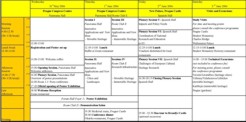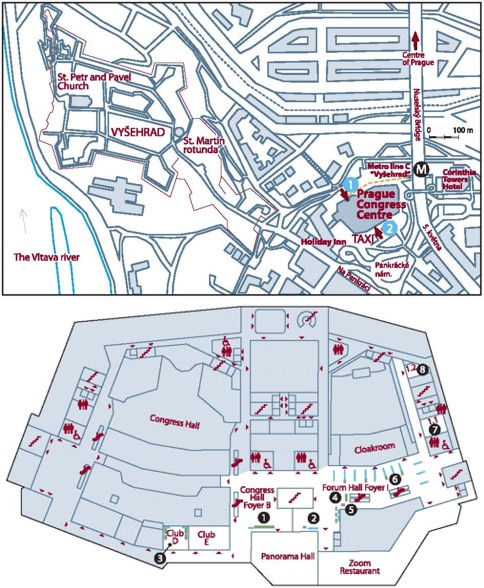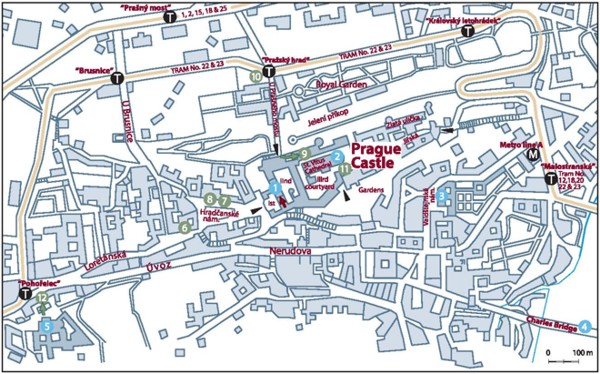|
The aim of the conference is the
consolidation and impact assessment of results achieved in EU research
projects related to movable and immovable cultural heritage. There will
be a special focus on exploitation and spin-offs of cultural heritage
research results and testing of the acceptability of new sustainability
approaches and new technologies by the user community, SMEs, and owners,
managers, restorers and conservationists of
cultural heritage.
Its main objectives are further to:
• Highlight the role of European cultural heritage research within
international activities and co-operation.
• Assess the impact of EU policies on the conservation of European
cultural heritage and evaluate the positive contribution of cultural
heritage research for competitiveness and job creation.
• Disseminate the results of EU cultural heritage research acquired at
large research facilities and discuss new development and innovations in
research infrastructure.
• Discuss and consolidate co-ordination of national research into and
educational programmes for cultural heritage within the enlarged Europe.
• Refine, amend and publish main ideas and visions of technological
platforms opened to cultural heritage issues in the context of
preparation of the 7th Framework Programme.
Language
The official language of the conference
is English
| Submission of
extended abstracts and posters |
March 31st, 2006 |
| Early
registration ends by |
March 31st, 2006 |
| Recommended
deadline for hotel booking |
April 15th, 2006 |
| Submission of
full papers for review |
May 31st
, 2006 |
| Conference |
May 31st
- June 3rd, 2006 |
Venue
The conference will be held in Prague. The conference sessions will take
place at
Prague Congress Centre for the first two days (May 31st
and June 1st) and at
Prague Castle on Friday, June 2nd.
The plenary session will be followed by study visits and technical
excursions on Saturday, June 3rd.
Prague Congress Centre (PCC) (May 31st and June 1st)
The Congress Centre is a well-equipped, modern conference facility. It
enjoys a unique location with a panoramic view of Prague.
The
Prague Congress Centre is on metro line C, right next to Vyšehrad metro
station (see
the map of the PCC). Instructions on how to get to the Prague Congress Centre are
included in the hotel description section on the conference Internet
site. The route from the metro station to the conference rooms will be
clearly marked. Delegates will be informed about the exact locations of
the sessions and social events during the event.
Spanish Hall, New Palace, Prague Castle (June 2nd)
The Spanish Hall is one of the most representative Ceremonial State
rooms at Prague Castle. It was constructed in the 16th century to house
the collections of Emperor Rudolph II.
The
entrance for the conference is by the Plecnik Staircase, which is
accessible from the passage between the First and Second Courtyards of
Prague Castle
(see the map of
the Prague Castle). Prague Castle has several entrances. A very convenient
way to get there is by taking tram no 22 or 23 to ‘Pražský hrad’, and
then walking down u Prašného mostu Street and into the castle.
Instructions on how to get to Prague Castle are included in the hotel
description section on the conference Internet site.
Travel
Prague International Airport has direct daily links to many cities in
Europe and handles flights from many places all over the world. The
airport is located 30 - 40 minutes by car from the centre of Prague.
There are good connections between the airport and Prague city centre by
public transport or by taxi. A taxi ride from the airport to the city
costs about 25 EUR.
Prague is the capital city of the Czech
Republic. Its historic centre has been listed in UNESCO’s World heritage
list since 1992. Prague has been attracting more and more visitors and
currently is one of the most popular tourist city destinations in
Europe. The main attraction is its architecture, consisting of both
monuments and a unique townscape. The historic centre of Prague still
keeps its mediaeval appearance and illustrates urban development in
Central Europe between the 14th and 20th centuries. There are a number
of architectural monuments of worldwide significance, such as Charles
Bridge, Prague Castle and St. Vitus Cathedral. For more information
about Prague please visit
http://www.pis.cz/en.
Hospitality desk
Our staff at the conference Hospitality Desk in the
Arrivals Hall of Terminal North 2 will be happy to assist you on your
arrival at the airport.
|
Tuesday, May 30th |
8am - 8pm |
|
Wednesday, May 31st |
8am - 1pm |

click to enlarge
Registration desk
The registration desk will be open from midday on Wednesday May 31st, 2006
until the end of the conference. Please allow sufficient time (at least
30 minutes) for registration before the programme begins at 3 p.m.
Plenary Session - Overview of poster
presentations (General Reports)
The plenary session consisting in three General Reports reviewing the
displayed poster contributions will be held on Wednesday May 31st.
Parallel and Plenary Sessions
The main sessions of the conference will be held on Thursday, June 1st
and Friday, June 2nd, starting on both days at 9 a.m. and running till
late afternoon (6 p.m.).
Invited lectures
The plenary session (Friday, June 2nd) on European Research within
the International Context comprises invited lectures from important
European and international bodies supporting cultural heritage research
(European Commission DG Research, UNESCO, Council of Europe, ICOMOS,
ICCROM, ICOM, Europa Nostra, Organisation of World Heritage Cities,
Getty Conservation Institute and Japan National Research Institute for
Cultural Properties).
Poster Exhibition and
Demonstration Salon
The Poster Exhibition and Demonstration Salon will be officially opened
by Václav Jehlička, member of the Senate of the Parliament of the Czech
Republic, during the Welcome reception. The posters will be displayed at
the Prague Congress Centre. The set-up time for posters begins with
registration at midday on Wednesday, May 31st. The Poster Exhibition
ends at 6pm on Thursday, June 1st.
Study visits
The following sites, all of which served as test sites or investigation
sites for EC-funded projects in the 4th to the 6th Framework Programmes,
have been selected for study visits.
Prague Castle
Meeting point: 9.00 at Prague Castle, at
the main entrance to St. Vitus’ Cathedral.
The castle and especially St. Vitus’
Cathedral (14th century) were used as a model site for a study of the
deterioration of typical historic materials in a polluted environment.
Its structures have been studied in several EC projects (COPAL, REACH,
CULTSTRAT, PICTURE).
Strahov Monastery
Meeting point: 9.00 at the main entrance to Strahov Monastery.
A National Heritage Monument, which contains
a rich collection of books of the National Library in its Baroque rooms.
A part of the LIDO project was carried out in the monastery museum.
Charles Bridge
Meeting point: 9.00 at the top of
Malostranska metro station, line A (at street level).
One of the oldest Gothic stone bridges in the
world and one of the most beautiful, with its collection of Baroque
sculpture decoration, which is being carefully studied within the
framework of several national research projects and also in the
EC-funded NOAH’S ARK project. The bridge has suffered several times from
flooding, and it is substantially impacted by the microclimate.
Wallenstein Palace
Meeting point: 9.00 at the top of
Malostranska metro station, line A (at street level).
The second largest historical complex
of buildings in the centre of Prague, and the seat of the Senate of the
Parliament of the Czech Republic. It has been recently restored and
granted a Europa Nostra Heritage Award Diploma. Its bronze sculptures
have been investigated under the COPAL and WET-CORR projects.
Technical Excursions
There is a choice of four technical excursions, offering a wide
range of interesting experiences for conference participants. The
options can be chosen according to participants’ research interests in
movable heritage, immovable heritage, urban heritage and gardens.
Meeting point: 14.00 at the Strahov Monastery Brewery restaurant. For
the exact position of the meeting point, please consult the map enclosed
in the conference programme.
Litoměřice + Terezín – two contrasting examples of urban
heritage. Litoměřice had a very rich and dramatic history from medieval
times to its High Baroque period, and was one of the cities where a
special ARCCHIP EC programme took place, in which the urban fabric was
studied. Terezín is composed of two interesting parts – a typical
military town from the 18th century and the WWII concentration camp,
which is a National Monument. Both suffered in recent extensive flooding
and have experienced significant interest from abroad.
The châteaux of Veltrusy, Nelahozeves and Liběchov – these are
examples of traditional Czech châteaux of different architectural styles
(Baroque and Renaissance) in the Vltava valley. They are in different
types of ownership (state or private) and house important art and museum
collections. Veltrusy Château was heavily flooded in 2002, and it has
been studied in EC-supported projects (ON SITE FOR MASONRY, NOAH’S ARK).
Karlštejn Castle – the most important and most fortified
medieval royal castle, which was heavily restored at the end of 19th
century. Some of its interiors, which have precious decorative work,
require the application of special visitor management and maintenance of
a controlled interior environment. Several national research projects
and one US/CZ project have helped to safeguard this important National
Heritage Monument.
Prague Gardens – one special technical excursion will be devoted
to visits to the recently restored gardens in the vicinity of Prague
Castle, with marvellous views over the Prague townscape.
Optional excursion
to Brandýs Castle, Friday June 2nd, 2006
Meeting point: 18.50 outside Lví dvůr
restaurant. For the exact position of the meeting point, please consult
the map enclosed in the conference programme.
An
optional excursion has been prepared by the organizers and the
Municipality of Brandýs nad Labem for the evening of Friday June 2nd.
Important restoration works of the remarkable medieval and renaissance
castle at Brandýs nad Labem have been carried out in a joint Czech-
Italian project. Participants will have an opportunity to visit the
restored part of the castle. Transport will be organized from the Prague
Castle (departure 19.00) to the Brandýs Castle and back (arriving in
Prague around 22.30). Participants will be able to have dinner in the
Castle winery. The bus tour and the guided tour of the castle are free
of charge. The dinner is not included.
Welcome reception, Wednesday 31st May
Following the welcome addresses and the opening of the poster display,
refreshments and a light buffet will be served to welcome the conference
participants.
Conference Gala Dinner, Thursday 1st June
The main social event, the Conference Gala Dinner, will be held on
Thursday evening in Vikárka restaurant at Prague Castle. The dinner is
not included in the conference fee and entrance is with tickets only.
The dinner starts at 20.00 with a short performance by a jazz band. For
the exact position of the Vikárka restaurant, please consult the map
enclosed in the conference programme.
Replica of a
Medieval Crane, Thursday 1st June
Conference participants have the opportunity to see a replica of a
medieval wooden crane from the period of years 1390 – 1400, which will
be exhibited at Prague Castle. Meeting at 19.30. For the exact meeting
point, please consult the map enclosed in the conference programme.
Lunch on
Friday 2nd June
Lunch for conference participants will be served in three local
restaurants: Tosca, U labutí and U Sv. Jana Nepomuckého. Participants
will obtain their lunch vouchers during registration for the conference.
Lunch on Saturday 3rd June
Lunch on Saturday will be served at the Strahov Monastery Brewery
restaurant. Participants will obtain their lunch vouchers during
registration for the conference.
Events, Concerts, Sightseeing
The 61st Prague Spring International Music Festival is on
during the conference, and many other cultural events can be found on
the Internet.
http://www.festival.cz/indexa.htm
(Prague Spring Music Festival)
http://www.pragueexperience.com/events/events.asp
The
Conference Secretariat will be pleased to advise you.
Contact:
Kateřina Adášková,
adaskova@cbttravel.cz
| |
by 31st
March |
from 1st
April |
| Full
participant |
290 EUR |
350 EUR |
| Student
fee |
100 EUR |
150 EUR |
Students
presenting a poster or paper
(max. 30
selected contributions) |
free of charge |
free of charge |
| International
Scientific Committee
|
May Cassar
Michel Chapuis
Elin Dahlin
Miloš Drdácký (Chairman)
Roman Kozlowski
Linda Krage
Paulo Lourenco
Johanna Leissner
André Loits
Adele Lydon
Claudio Modena
Ioanna Papayianni
Jean-Marc Vallet
Takayoshi Yamamura
| Poster
Session General Reporters |
Cristina Sabbioni (immovable heritage)
Matija Strlič (movable heritage)
Jacques Teller (cities, villages & landscape)
| Local
Organising Committee
|
Kateřina Adášková
Natalia Cavina
Jitka Drdácká
Eliška Fučíková (Chairperson)
Zuzana Tesařová
Šárka Tittlebachová
Jan Válek (Secretary)
| For further
information please contact the Organising Committee:
|
Dr. Jan Válek
Institute of Theoretical and Applied Mechanics, Academy of Sciences CR
Prosecka 76, 190 00 Prague 9, Czech Republic.
Phone: +420 283880458
Fax: +420 286884634
E-mail:
ecconference@arcchip.cz
E-mail:
valek@itam.cas.cz
www.arcchip.cz/ecconference
Prague Congress Centre Area (Download
map - pdf)

Prague Castle Area (Download
map - pdf)

|